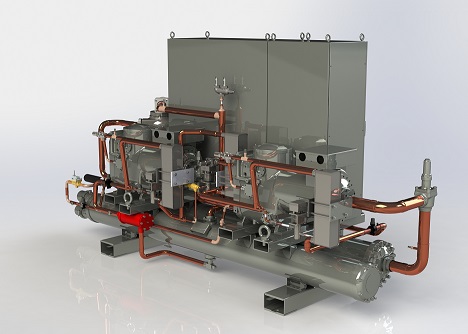BEN
High Temperature Heat Pumps – for Retrofits
High Temperature Ground Source Heat Pumps for Retrofits
The coefficient of performance of a heat pump will generally improve the lower the output temperature it is asked to deliver: therefore the designer aims for a well designed heat emitter system such as underfloor heating where 40°C is sufficient to provide comfortable room temperatures. However, if a heat pump is to be used in an existing building with limited heat emitters for the heat load, such as standard radiators, then it will be appropriate to specify a high temperature heat pump to avoid the disruption that would be caused by refurbishing the heat emitter systems throughout the building.

There are now ground source heat pumps capable of delivering output temperatures of 80°C which is more than sufficient for hot water needs and to warm a building with standard sized radiators. Although the CoP will fall if output temperatures are raised to 80°C, a well designed inverter-driven high temperature heat pump with a good control system, including weather compensation, will only deliver 80°C when it is required: otherwise it will modulate the heat pump to deliver lower temperatures – at a higher efficiency – when the heating load is below peak requirements.
Coefficient of Performance – CoP
The key to the efficiency of a heat pump is the Coefficient of Performance: the “CoP”. In spite of the first law of thermodynamics, which tells us that energy can neither be created nor destroyed, a GSHP in a good installation can yield over four units of heat for each unit of electricity consumed. The heat pump is not creating this energy, but merely separating a medium temperature from the ground into hot (which can be used for heating) and cold (which can be returned to the ground).
The CoP will vary with each installation, but the lower the output temperature to the heat distribution system the higher the CoP will be. If an output temperature of 65°C is needed to heat radiators the CoP is likely to fall to level of only 3.0. If the heat distribution is to a well designed underfloor heating system that works well at an output temperature of 50°C then the CoP can rise to a level above 4.
The input temperature is also critical to the CoP of the heat pump. The higher the input temperature from the ground, the lower the amount of work needed from the heat pump, the higher the CoP will be. In fact, the critical factor is the “uplift” between the source temperature and the output temperature. Therefore a GSHP may be more efficient in the autumn than in the depths of winter.
Demand Side Response
The timing of providing heat to a building can also be managed using Demand Side Response. If the control system is aware of the fluctuating price of electricity over each 24-hour period, the control system can exploit the thermal inertia of the building. Low level heat can be provided when electricity is cheapest to maintain the core temperature of the building, and heating can be boosted before peak price hours when the heating can be turned down.
High Temperature Heat Pumps and District Heating
High temperature heat pumps are critical in allowing new district heating networks to be installed to serve older buildings – without refurbishing their heat distribution systems – as well as serving modern buildings with warm temperature heat pumps on the same heat sharing district heating network.
ICAX High Temperature Heat Pumps at LSBU
ICAX High Temperature Heat Pumps have been installed at London South Bank University and provide water at up to 80°C to heat the buildings where they have been installed in place of gas boilers.
These heat pumps are tuned to respond to Demand Turn-up or Demand Turn-Down from the Grid, when it is appropriate to do so.
Gas boilers have been retained as back up, but these are rarely used.

